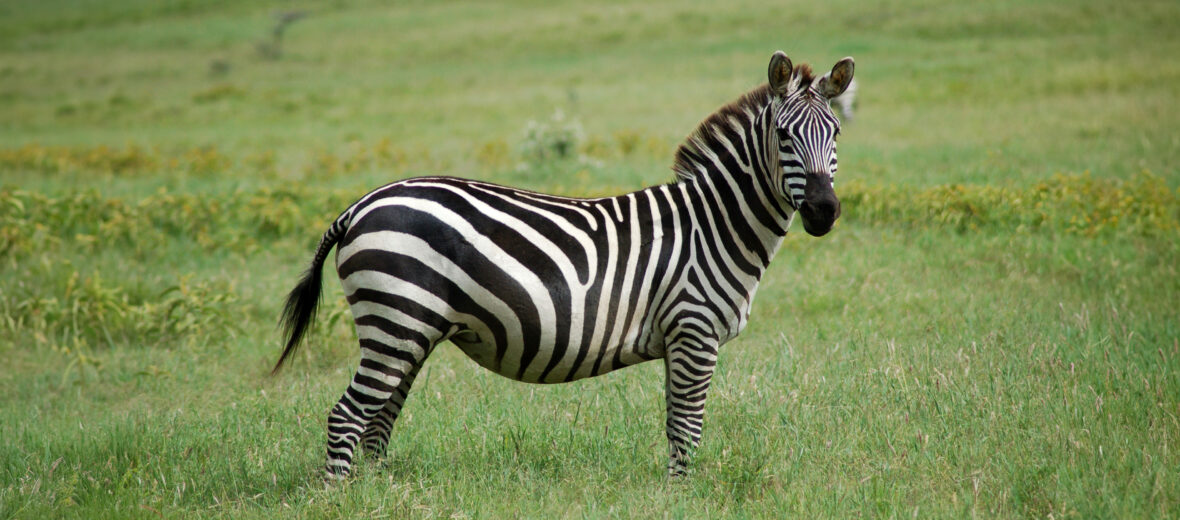
The plains zebra is the most geographically widespread species of zebra. There are 6 subspecies, or clines currently recognized. They suffer fragmentation throughout their range of southern to eastern Africa, south of the Sahara. These zebras face the threats of habitat loss at the hands of farming and ranching; hunting; trapping; war; civil unrest; and climate change, which causes severe droughts. The IUCN lists these zebras as Near Threatened. There were an estimated 250,000 wild individuals remaining as of 2016, but those numbers are decreasing.
First the Stats…
Scientific name: Equus quagga
Weight: Up to 710 lbs.
Length: Up to 97 inches, plus up to a 22.2 inch tail
Height: Up to 55 inches
Lifespan: Up to 25 years
Now on to the Facts!
1.) These zebras tend to be sized in between the Grévy’s zebra and the smaller mountain zebra. But have thicker stripes than both.
2.) Lions, spotted hyenas, Nile crocodiles, leopards, cheetahs, and African wild dogs all prey on these critters.
3.) The plains zebra forms harems consisting of a single stallion, numerous mares, plus their young offspring.
4.) Harems keep a vigilant watch out for predators and will bark and snort when 1 is detected.
5.) These zebras were originally classified by British zoologist John Edward Gray in 1824 as Equus burchellii. After the quagga, described by Pieter Boddaert in 1785, was found to be the same species, in the 21st century, the plains zebra was then reclassified as Equus quagga.
But wait, there’s more on the plains zebra!
6.) Different species of zebras often co-exist in the same herds and as a result, fertile hybrids often exist.
7.) Plains zebras are water-dependent and dwell in more mesic (containing water) environments than other African equines. They seldom wander more than 7.5 miles from a water source.
Did you know…?
These zebras can produce upwards of 6 different calls. 1 of which is a “a-ha, a-ha, a-ha” or “kwa-ha, kaw-ha, ha, ha” sound.
8.) They primarily graze on various grass species, but during the dry season, then will also dig up and eat rhizomes and corms (swollen, underground stems of a plant that stores nutrients and starches).
9.) These zebras are diurnal (active during the day).
10.) At night, they will usually sleep laying down, while 1 or more individuals stay awake and keep a watchful eye for predators.
But wait, there’s still more on the plains zebra!
11.) Stallions form & expand their harems by stealing young mares from their natal harems. When a mare reaches sexual maturity & has her first oestrous cycle, she attracts the attention of numerous nearby stallions, both in bachelor and harem herds. Her family stallion (typically her father) attempts to ward off or fight stallions attempting to abduct her.
12.) When a mare finally ovulates, the male that impregnates her keeps her in his harem. Then the mare becomes a permanent member of the new harem.
Did you know…?
Zebras have been depicted in rock art in Southern Africa (what is now known as Botswana, Namibia, and South Africa) dating back as far as 28,000 years ago.
13.) If challenged, the stallion with a harem gives a warning to the challenger via rubbing noses or shoulders with him. If the warning is ignored, a fight will ensue. Zebra fights are typically violent, with each male biting at one other’s head, neck, or legs, wrestling the other to the ground and occasionally kicking.
14.) 2 primary facial expressions are made by these zebras; the greeting and the threat. In both instances, the lips are pulled back and chewing motions are displayed. This is coupled by flattening the ears backward.
15.) The greeting gesture involves the ears sticking up and moving forward.
But wait, there’s still a bit more on the plains zebra!
16.) Males exhibit the flehmen response to test for mating receptivity. This involves the upper lip being curled back to smell for urine (with the vomeronasal organ).
17.) A female will signal her readiness for copulation by raising her tail and straddling her legs.
Did you know…?
The plains zebra is the national animal of the Republic of Botswana. Its stripes are even displayed on the country’s flag. The stripes on the flag also represent racial harmony within the country.
18.) Females undergo up to a 12 month gestation (pregnancy) that yields a single foal.
19.) The foal weighs up to 77 lbs. at birth and is born precocial (self sufficient) and able to stand just minutes after birth. In just a couple weeks the foal is eating grass.
20.) Complete weaning takes place in up to 11 months.
Now a Short Plains Zebra Video!
Be sure to share & comment below! Also, check out the Critter Science YouTube channel. Videos added regularly!
Want to suggest a critter for me to write about? Let me know here.
Some source material acquired from: Wikipedia & IUCN
Photo credit: Joachim Huber



